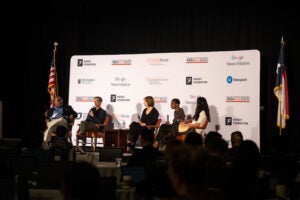April 16, 2023 | Editorial Journalism, ISOJ2023, Trust
Opinion editors from four major U.S. newspapers discuss the future of these sections, their audiences and new formats
The third panel of the opening day of the 24th International Symposium on Online Journalism (ISOJ) began with the premise of demystifying opinion journalism, explaining the editorial process and thinking about the future of these op-ed sections.
Michael Bolden, CEO and executive director of the American Press Institute, moderated the panel, which included Nancy Ancrum, editorial page editor of the Miami Herald; James Dao, editorial page editor of The Boston Globe; Zeba Khan, deputy editorial page editor of The San Francisco Chronicle; and Kathleen Kingsbury, opinion editor of The New York Times.

The op-ed teams of each of these media vary in size. From seven people at the San Francisco Chronicle to 200 at The New York Times. Still, all share the challenge of maintaining their audience and reaching new readers.
“One of the first things I added [upon arriving at The Boston Globe] was a social media editor, because we had one person who was doing all the online stuff,” Dao said. This allowed them to have one person dedicated solely to expanding the audience and thinking strategically about creating content.
Use of newsletters in opinion
The media represented in this panel, with the exception of the San Francisco Chronicle, have exclusive newsletters for their op-ed pages. These newsletters have allowed them to connect with their audience and, in many cases, keep their paying subscribers loyal.
“When I first got there [to The Boston Globe] we had the typical newsletter with a list of all our pieces and it wasn’t curated and it was weird. It didn’t make a lot of sense. So we’ve organized it and now we write a short introduction and then include more things based on what we think is important … We’ve also encouraged columnists to do their own newsletters,” Dao said.
For Dao, newsletters are now their own form of content and are not just a way of providing links to news pieces.
In the case of the Miami Herald, they have dozens of newsletters, including three in the opinion category. According to Ancrum, these have the highest readership rates of all the newsletters within McClatchy, the Miami Herald’s parent company.
Ancrum said they also pay special attention to the writing of their newsletter introductions as a way to engage their audience.
As for The New York Times, its newsletters have played a special role in its growth and maintenance of subscribers.
“We found that newsletters are a great tool for retaining subscribers. So we have presented newsletters as a value-added proposition for being a New York Times subscriber. Although, we do have several newsletters that you can get for free, such as Opinion Today, to which we have about a million subscribers to this point,” Kingsbury said.
Mission statement
Another question raised by Bolden was whether the media present on the panel had, in their op-ed section, a mission statement and how they communicated it to the public.
“We don’t have a mission statement formulated. But I think amongst our team we’ve talked about what matters to us and what are the goals of the opinion page and that’s sort of our guiding compass for how we seek out external contributors and how we look at pieces that come,” Khan said.
The other panelists agreed with Khan.
“We have a set of values that dictate a lot of work for the editorial board, which is publicly on our website,” Kingsbury said. “I mean, we do talk a lot about what our mission is in Times opinion amongst ourselves on our staff, but I think it has been very helpful for us to really articulate what we’re trying to do every day.”
New formats in opinion journalism
Writing is not the only format for expressing opinion. Nowadays, the opinion sections of the media are exploring new formats such as podcasts.
During the panel, the Miami Herald took the opportunity to showcase the promotion of its new podcast called Woke Wars. For Ancrum, the podcast has been a branding exercise and the listening numbers show that it works.
Moreover, media outlets such as the Boston Globe are also exploring video opinion or through social networks such as Tik Tok.
The panel closed with a conversation about the role of opinion journalism in the audience.
“I got on the plane today, this morning, first thing I saw was a man on the escalator in front of us and his T-shirt said, ‘The only deadly virus in this country is the media,’” Ancrum said. “And my response [to those who believe the media tell them what to think] is we don’t tell you what to think, we tell you what to consider.”

